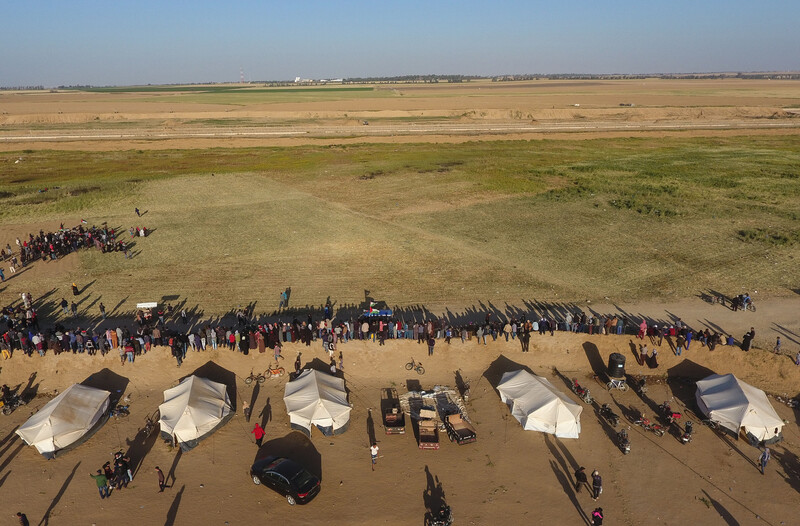The Electronic Intifada 12 December 2019

Akram Agel paints tributes to victims of Israeli violence.
The Electronic IntifadaIn his painting “Target Bank,” Akram Agel offers a potent tribute to Palestinians killed by Israel.
By packing various colors together, he lends an otherworldly quality to the faces of victims. Though the images are sad and painful, the victims seem to have achieved a sense of calm or release.
Agel paints from a small workshop in Jabaliya refugee camp, north of Gaza City. He is among the many artists who have participated recently in Return Journeys, a series of events celebrating Palestinian culture.
“We are sending a peaceful message to the world about the brutal way Israel deals with women and children,” he said.
The Return Journeys were founded by the campaigner Ahmed Abu Artema. He also conceived of the Great March of Return protests held in Gaza on Fridays.
It is no accident that the word “return” features in both activities. They emphasize that Palestinian refugees have a right – recognized by the United Nations – to go back to villages and cities from which they were expelled by Zionist forces in the 1940s.
“We are demanding our rights through music and art,” said Abu Artema. “We are expressing the fact that we are a nation which loves life.”
Abu Artema stressed that the Return Journeys are “not a replacement” for the Great March of Return. Both are part of the same struggle.
“Safe environment”
One distinction can nonetheless be drawn.
The Great March of Return has posed a direct challenge to the Israeli occupation. Palestinians have repeatedly shown great courage by venturing toward the fence separating Gaza and Israel. More than 200 have been killed by Israeli snipers since the weekly protests began at the end of March 2018.
A United Nations commission of inquiry found that Israel may have committed war crimes and crimes against humanity by using lethal military force against unarmed protesters during the Great March of Return.
The Return Journeys are not as confrontational. The aim is “finding a safe environment for people that restricts the occupation’s chances to inflict casualties,” said Abu Artema.
Tents used during the Return Journeys – generally held on Tuesdays or Wednesdays – are erected around two kilometers from the boundary fence.
The organizers hoped that would be sufficiently far away from the Israeli military for the events to take place without any hassle. Israel has nonetheless fired tear gas projectiles toward participants in one of the Return Journeys. Despite that attack, the event went ahead as planned.

The tents used for the Return Journeys are erected about two kilometers from the fence separating Gaza and Israel.
The Electronic IntifadaAlthough the Return Journeys generally keep their distance from the boundary fence, the organizers sought to make an exception while planning to mark the anniversary of the Balfour Declaration last month. That 1917 commitment by Britain to help found “a national home for the Jewish people” in Palestine was an important milestone in a process leading to the mass expulsion of Palestinians three decades later.
Ahmed Abu Artema sought to commemorate the anniversary by having elderly Palestinian citizens of Israel and residents of Gaza meet at the boundary fence so that they could exchange letters from one side to the other. The Israeli military would not allow the gathering to take place.
Abu Artema acknowledged that the Israeli refusal was expected. “But we insisted on trying,” he said.
“Peaceful road”
Ali al-Sammak recites poems – written by himself – in an impassioned style. He has previously given performances during the Great March of Return.
“When the Return Journeys were organized, I had the chance to read my poems and to be heard without Israel disrupting us with bullets and tear gas bombs,” he said.
Rana Elramlawy has made sand sculptures during the Return Journeys. One such sculpture is inspired by a 2005 photograph showing an elderly woman hugging an olive tree in the occupied West Bank, observed by Israeli soldiers.
“This image has been stuck in my head since I was a child,” said Elramlawy, 23. “The olive tree symbolizes the Palestinian attachment to our lands. And for me, this sculpture embodies our commitment to the right of return.”
Along with art, the Return Journeys stress the importance of traditional food as part of Palestine’s heritage. The dishes served during the events have included sumaghiya, a beef and chickpea stew, and maqlooba, a blend of spiced rice, vegetables and meat.
Sabreen al-Najjar has overseen the culinary activities as part of the Return Journeys. She heads a team that comprises tens of women.
Sabreen views her participation in the event as a way of preserving the legacy bequeathed by her daughter Razan. A medic, Razan was shot dead by an Israeli sniper as she tended to the wounded during the Great March of Return last year.
“I am taking part in these events so that I can continue going down the peaceful road my daughter was on and for which she paid with her life,” said Sabreen. “I am showing my solidarity with the protesters and the victims.”
Sarah Algherbawi is a freelance writer and translator from Gaza.





